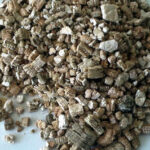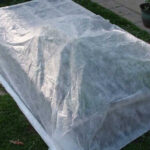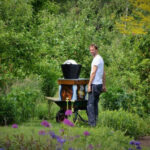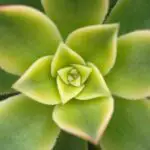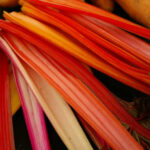When autumn comes in the Americas, spice is the name of the game. Baked goods, coffees, and warm dishes sport autumn spice blends we all know and love. Mace and the spice nutmeg accompany others in multiple forms. But did you know that these spices both grow on a nutmeg tree?
Nutmeg and mace come from the tropical tree, Myristica fragrans. Nutmeg trees originate in the Spice Islands, an archipelago of the eastern part of Indonesia. This region was one of the main stations of the spice trade among European colonists as far back as the 16th century BCE.
Although it took a long time for nutmeg trees to make their way to the Americas, they’re here! And you can cultivate that distinctive pungent fragrance that nutmeg seed brings wherever it’s added. In this guide, we’ll talk about how you can grow your own nutmeg trees at home.
Quick Care Guide
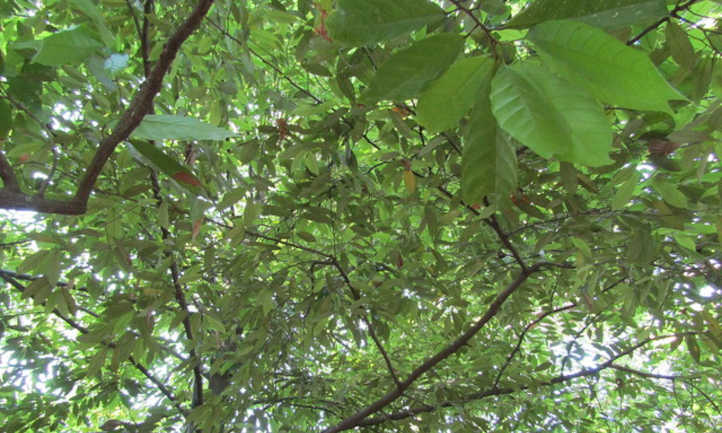
| Common Name(s) | Common nutmeg, fragrant nutmeg, true nutmeg, mace |
| Scientific Name | Myristica fragrans |
| Days to Harvest | 150 to 180 days (from planting a mature tree) |
| Light | Part sun |
| Water | Up to 2 inches per week |
| Soil | Fertile, well-draining |
| Fertilizer | Composted cattle manure or occasional liquid fertilizer |
| Pests | Cocoa weevil |
| Diseases | Anthracnose leaf spot, thread blight |
All About The Nutmeg Tree

Nutmeg trees (known scientifically as Myristica fragrans) produce both nutmeg and the spice known as mace. Fragrant nutmeg and mace are common names associated with nutmeg trees. The trees are the origin of the nutmeg Americans know and love.
Nutmeg trees are native to the Spice Islands of Indonesia. It’s here that Portuguese colonists acquired knowledge of the plant from the West Indies and took it back with them to Europe in the 16th century. It wasn’t until the 19th century that this tropical tree was cultivated outside the Maluku Islands.
Nutmeg trees are evergreen with smooth fragrant, dark green leaves that resemble that of magnolia. Female trees have 3 to 4 lobed petal-less flowers. Male trees have up to 20 stamens per flower. Fully mature nutmeg trees grow anywhere from 30 to 60 feet tall.
Through the process of pollination between male and female flowers, often carried out by a nocturnal beetle, nutmeg plants bear fruit in a teardrop form of green to yellow tender flesh. Inside, the seeds are grayish-brown ovals with furrowed surfaces and a hard red-colored aril seed coat. Home cultivators who are in the for the long haul grow both a male and female tree and hand pollinate them to produce nutmeg seed. Trees produce nutmegs around age 5, and the total lifespan of a tree is up to 60 years.
Fresh nutmeg pulp can be removed to expose the seed kernels that become dried nutmegs. Grated nutmeg becomes nutmeg powder, used as a spice across the world. The crimson-colored aril that exists atop the seed’s hard surface is separated, dried gradually, and used as the spice mace. Although these trees are specifically tropical, they’re easy to cultivate in the right conditions. Growers with greenhouses in cooler areas of the world can have just as much success as those in warmer areas.
The fruit itself is edible and you can make nutmeg juice from that fruit, which is a delicacy widely served in coffee shops in its native region. Those who have spread the benefit of this generous species in their culinary practice have described it as startling and surprising outside of the American context most of us know spices like nutmeg for.
Planting
When you purchase nutmeg trees, wait until the roots fill the nursery pot before transplanting. Unless you live in tropical areas, plant your trees in a container. As growth occurs, gradually transfer the trees into containers with 2 more inches of width and depth as the last, making sure the roots aren’t circling around the pot. Eventually, plant your trees in 5-gallon pots (we sell 5-gallon Air Pots which are expertly-crafted for growing trees). Once the roots fill this area, plant them in their final resting place — either in a container or in-ground (we have a 10-gallon Air Pot that works well for growing nutmeg).
Make sure to allow at least 30 to 40 feet between nutmeg plants grown in the earth. Those grown in containers will do just fine as long as they are in good condition. Because these are tropical plants, they should not be planted or transplanted in cool weather. Make sure they are in a sunny area with good, consistent humidity. Avoid areas with high winds, or cold, dry air. Give the plant fertile soil with good drainage.
Care
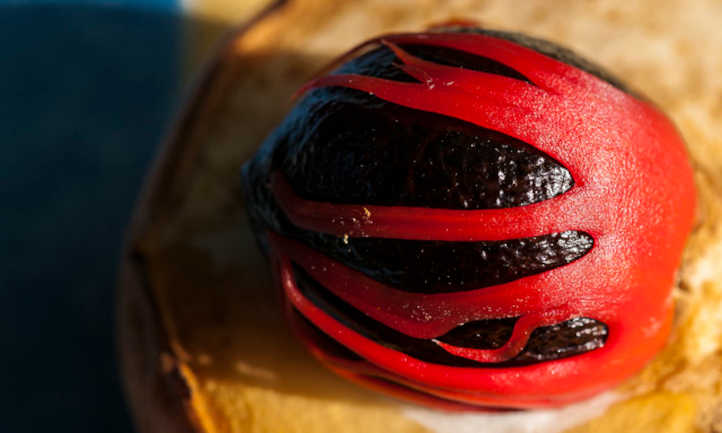
Nutmeg does great once it’s established after planting. Let’s discuss the framework for successfully growing nutmeg.
Sun and Temperature
Nutmeg loves areas that get full sun to partial shade to full sunlight at 4 to 6 hours daily. They thrive in USDA zones 10 and 11. Again, it’s possible to grow this tree outside that range, just in containers. The optimal temperature range for a nutmeg tree is 77 to 86 degrees Fahrenheit. Therefore, it’s best to cultivate this tree outdoors in an area that has hot summers and mild winters, and to bring in container-grown trees in climates outside that range.
Too much sun will scorch the leaves of your tree, whereas too much shade will starve nutmeg of nutrients. Additionally, too much cold will easily kill nutmeg, especially below 30 degrees Fahrenheit. If you garden this tree in USDA zones outside of the ideal range, make sure you have a greenhouse or indoor space to shelter your plant from weather extremes. Outside the optimal temperature range, a nutmeg tree will stop flowering and drop fruit. Pollination at this time becomes more difficult. Keep it in that range, and you’re set!
Water and Humidity
Water nutmeg in the morning when the surface 2 inches of soil is dry. In containers, water the tree more often following the same rule. Containers tend to dry out soil faster.
In the garden bed or yard, a good 2 to 3-inch layer of mulch will help keep the soil moist. Set a drip irrigation line around the base of your tree, away from the trunk. If your tree is exposed to extended periods of rain, avoid watering until the top layer of your planting medium becomes dry again. Do not allow the soil to dry out. Nutmeg is native to areas that have consistently moist soil, so give it the same to be successful.
If you live in an area with less than 85% humidity, regularly mist your tree to the point where water pools on the leaves but does not drip off. Do this up to 2 times daily if needed.
Soil
Use a highly fertile soil type with good drainage for planting this tree in your garden. Most experienced nutmeg growers use a well-draining soil base with well-rotted manure (often cow manure) and a little bit of sand mixed in. If planting directly in the soil, work in a good amount of composted manure prior to planting. Although nutmeg can survive in poor soil, it needs more than that to pollinate and fruit. In general, lightly acidic soil is best. Test your soil for a pH range between 5.5 and 7.0.
Fertilizing
Because nutmeg grows in large amounts of well-rotted manure, it doesn’t need much extraneous nutrient content. However, a monthly liquid application of a diluted organic fertilizer with a 20-18-50 base NPK doesn’t hurt. Gradually increase this amount each year as the tree grows. Alternately, spread additional composted manure around the tree annually.
Do not fertilize when it’s too hot or too cold. This could either promote rot in your nutmeg roots or burn the plant.
Pruning
In young trees, prune off branches that grow inward toward the trunk. As nutmeg ages, branches at the bottom of the tree should be pruned to lift the crown and give you space below. Some say more branches mean more fruits, while others say pruning promotes fruits and flowers. You’ll have plenty of time to play around with this and see what works best for you.
As the tree gets larger, have someone spot you when pruning high-up branches. Alternatively, hire an arborist to help you shape nutmeg. When the fruits are ripe, they will split and fall to the earth. It can also be picked off the tree just before the flesh splits if you want to use the flesh as well. Because nutmeg is evergreen, it does not drop its leaves and is not deciduous.
Propagation
As nutmegs fall to the ground when they’re ripe, they could end up in the optimal shade and moist soil and propagate on their own. Simply dig up the seedling with its new growth and transplant it into a gallon container with the same soil you’d give to your mature tree.
Alternately, remove and plant seeds yourself. As the fruit and seeds drop, place the seeds in an envelope or paper bag and put them in the refrigerator. They’ll remain viable for up to 45 days. Soak them for at least 24 hours in clean water, and then plant them in 5-inch starter pots 1 inch deep. Keep the soil moist and in six to eight weeks you’ll have a sprouted nutmeg.
Recently, work has been done in grafting male nutmegs onto female nutmeg. This is a way to produce a tree that self-pollinates. If you have a mature female nutmeg, you can graft a male branch onto a healthy female tree.
Harvesting and Storing
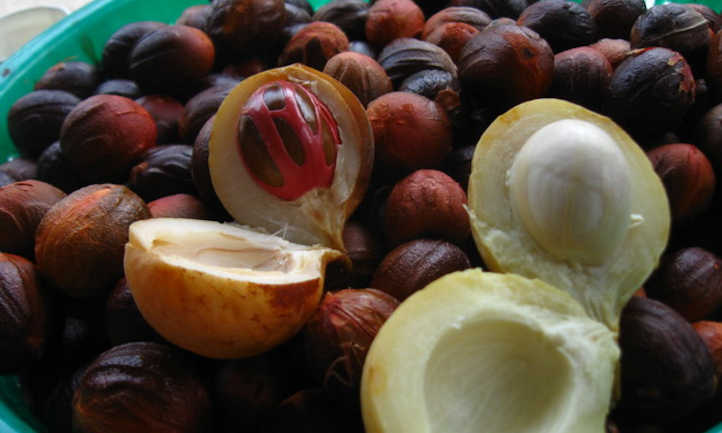
So you’ve done the planting, soil maintenance, and you’re well on your way to having your own ground spice nutmeg. Let’s talk about the process of removing seed, processing, and storing nutmeg. You’ll have a warm dry flavor of these spices in any dish you like.
Harvesting
As the fruit opens and exposes the seed, nutmegs are ready to harvest. Either wait for nutmegs to drop in the area your tree is planted, or remove them with a long pole. Remember that you won’t see ripe fruit until at least 5 years of healthy growth.
Separate the red aril from the seed casing. The seed casing will need to be separated from the seed once the seed dries out fully. The casing can be composted or discarded. The aril should be dried for 2 weeks in direct sunlight. Then it can be ground in a mortar and pestle into powder.
To dry nutmeg, allow it to sit in sunlight for 6 to 8 weeks until the nutmeg shrinks and the kernels rattle within. It’s this kernel that is the nutmeg we know and love, so crack the outer casing and extract your prize. The kernel itself can be ground with a microplane grater or nutmeg grater. Note the flavor of freshly ground nutmeg will be much stronger than stored powder. Use your sense of smell and taste to determine if you need to cut back on powder in your sauces, beverages, desserts, and meats.
Storing
Whole nutmeg (and its flavour) can be kept in a dry airtight container at room temperature for up to 5 years. Ground nutmeg keeps this way up to 3 years.
Mace should be stored in a cool dark place in an airtight container as well. It will last for 1 year but will begin to lose its potency after 6 to 8 months.
Having fresh-ground nutmeg and mace for vegetables (like potatoes), meat, or to spread around various dishes is truly lovely.
Troubleshooting

Growing nutmeg can be difficult when conditions aren’t right. Here are a few things to be aware of.
Growing Problems
If you grow nutmeg in soil that isn’t fertile or soil that isn’t moist enough, it may not flower or fruit. By year 7, if the flowers haven’t grown, fertilize just a little more than you did last year.
Nutmeg needs a bit of shade. With too little shade, the leaves can singe and nutmeg drops from the tree. At the same time, too little sun will make them unable to synthesize their nutrients.
If you plant your tree in a hole that is too deep or a hole that is too shallow, it may not take root properly. Replant deeper soon after if you notice exposed roots.
Make sure you leave a small gap between any mulch and the trunk of the tree. This gap prevents potential fungal or mold damage to the trunk.
Pests
Cocoa weevil digs a circular hole through the casing into the nutshell and eats the kernel. If you notice your nutmeg has a hole in it, treat your tree immediately to prevent total kernel loss. Weevils will not only eat the kernel but lay eggs in the hole allowing larva to proliferate. These are often treated with organic fumigants applied to kernels. Plant plants that encourage their natural predators, like mantises, birds, and ladybugs, or introduce these beneficial predators to your garden. Organic spinosad spray is a good pesticide choice for weevils.
Diseases
Anthracnose leaf spot is caused by the fungus Colletotrichum gloeosporioides, and presents as spots with yellow halos on the leaves of your tree. To treat leaf spot, use a 1% Bordeaux mixture (a blend of copper sulfate, hydrated lime, and water) in liquid form and spray your leaves. For an easier, off-the-shelf treatment, a liquid copper fungicide is also effective.
Thread blight is also caused by a fungus. Corticium spp. is the pathogen in this case. It either produces white or black silky threads that form an irregular network on stems and leaves. This is also treatable using a liquid copper fungicide or a 1% Bordeaux mixture.
Frequently Asked Questions
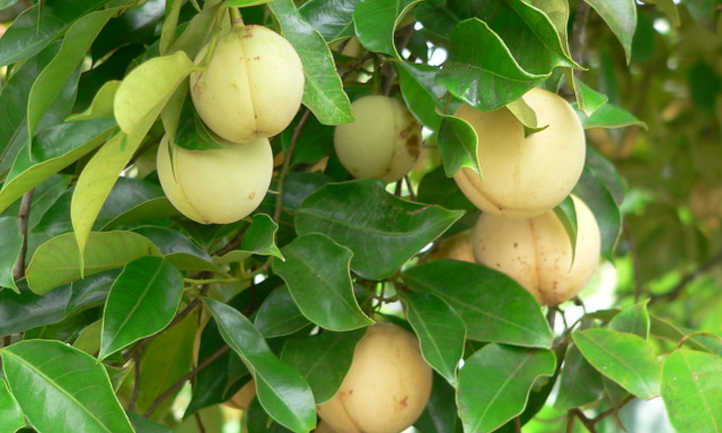
Q: Can I grow a nutmeg tree?
A: Yes! It will take time, but once you establish this plant you’ll be so glad you did.
Q: Can you eat the nutmeg fruit?
A: The pulp around the fruit is reputed to be quite sweet and popularly juiced in Asian countries. It has a different flavor than the spice but is very tasty!
Q: How long does a nutmeg tree take to grow?
A: Nutmeg produces fruit after at least 5 years of healthy growth and proper pollination.

